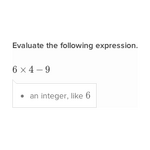| Order of operations | |
|---|---|
 | |
| Description | |
| Exercise Name: | Order of operations |
| Math Missions: | 6th grade (U.S.) Math Mission, 7th grade (U.S.) Math Mission, Pre-algebra Math Mission, Mathematics I Math Mission Algebra I Math Mission, Mathematics II Math Mission |
| Types of Problems: | 1 |
The Order of operations exercise appears under the 6th grade (U.S.) Math Mission, 7th grade (U.S.) Math Mission, Pre-algebra Math Mission, Mathematics I Math Mission, Algebra I Math Mission and Mathematics II Math Mission. This exercise practices the order of operations, also called PEMDAS, in arithmetic.
Types of Problems[]
There is one type of problem in this exercise:
- Evaluate the expression: This problem provides a numerical expression using any of a number of arithmetic operations. The user is expected to correctly follow the order of operations and find the correct simplification of the expression.

Evaluate the expression
Strategies[]
This exercise is easy to get accuracy badges with a firm knowledge of the order of operations. The speed badges are easy also because all the numbers involved are small, and in most cases, there are only two steps to the answer.
- The most common order of operations is Parentheses, Exponents, Multiplication and Division, then Addition and Subtraction.
- The order of operations is also simplified to the mnemonic device PEMDAS or GEMDAS (if "grouping symbols" are substituted for "parentheses").
Parentheses, Exponents, Multiplication, Division, Addition, and Subtraction
- The acronym "Please excuse my dear Aunt Sally" is also commonly used.
- When there are equally strong operations they are all to be performed in order from left to right.
- The order of operations arises because multiplication is effectively repeated addition, and exponentiation is effectively repeated multiplication.
Real-life Applications[]
- Order of operations helps people understand mathematical concepts better when they can relate them more closely to their own lives.
- Order of operations are sometimes needed in computer programming because some expressions may not be solved properly.
